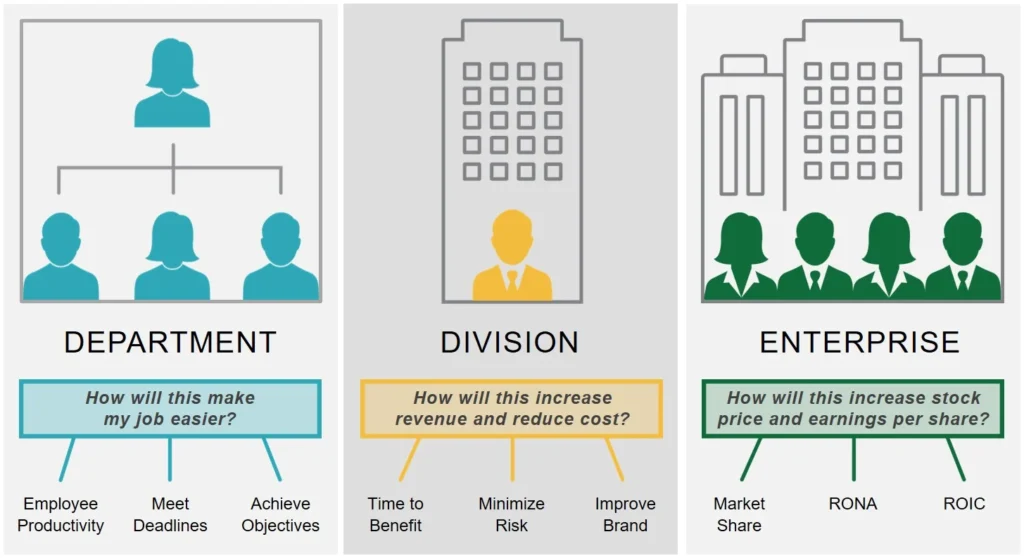An effective business case conveys your solution’s value and impact as they relate to the specific needs of your buyer. Although different levels of approval are often needed, a business case should be tailored to include the messaging and metrics most important to the decision maker.
So how does your solution impact the buyer’s organization? If the investment is large enough and has a material impact on the overall enterprise, your value selling tools and resulting business case will likely be tailored for the C-suite. Otherwise, it will focus on the needs of a specific department or division and be sponsored by appropriate levels of management.
Targeting Your Financial Justification
There is no one-size-fits-all approach to creating a business case. Decision makers’ needs vary by their role in the organization. Wherever the buyer is positioned, you must tailor your output to fit a typical buyer profile and configure your financial justification around the metrics they care about.
Additionally, regardless of the buyer’s place in the organization, the size of the investment and resulting level of disruption play a role. For example, a small investment in a niche-specific platform subscription requires less scrutiny than an enterprise-wide technology deployment.
Consider how your solution impacts these three levels of buyers.

Department Level
Buyers at the department level are focused on improving employee productivity, building employee satisfaction, and completing projects on time and within budget. Oftentimes at this level, the financial justification should focus on projections such as labor savings.
One of our clients sells specialized electrical transmission wire to utility companies. Although their material costs are greater than the alternative, their overall solution reduces the installation and maintenance costs for specific project requirements. The TCO tool used by their sales team shows department heads how many fewer truck crews are needed to maintain the grid in their assigned area.
Division Level
Within a division, approvers may be evaluating a solution’s impact across multiple departments and value dimensions. The business case should holistically look at projected cost savings and/or revenue improvements. The division head will also be looking at tangential benefits that might be hard to quantify, but deliver value nonetheless.
Another client sells a software platform that helps telecommunications companies build and maintain cellular and broadband networks. The ROI tool we built for this client not only shows the expected savings from requiring less programmer time, but considers other benefits such as avoided capital expenditures and increased revenue from subscriber growth.
Enterprise Level
C-suite executives need to be presented with the big-picture fiscal impact. They want to know if the projected results will materially affect the company’s valuation and stock performance, and by how much. These tough questions need to be considered in advance of presenting your business case.
We have a client whose solution reduces the cost of a large line-item expense in most companies: employee health benefits. We configured their value selling tool to focus on high-level metrics such as the increase in company valuation. Another metric used is sales equivalency, which measures the incremental sales revenue needed to have the same bottom line impact as the projected cost savings.
Decision Makers Want Your Help
Providing buyers with a tailored business case helps them meet the challenge of financially justifying a desired purchase. Building business cases is not their primary job, so they are receptive to vendors providing the metrics and messaging needed to move a buying decision forward.
Some buyers lack the expertise to build a solid business case that clearly presents the advantages of your solution. Others may not be aware of how your solution impacts their organization. Sellers that can provide a holistic financial analysis of the solution at hand can reduce internal friction for their buyers and close more sales.
Conclusion
Target your financial analyses to reflect the needs and role of each decision maker. Address their specific objectives and configure results around the metrics they care about most. Buyers will welcome your help advancing the buying decision with a focused and persuasive business case.

Resources
Connect with David Svigel on LinkedIn.
Join the Value Selling for B2B Marketing and Sales Leaders LinkedIn Group.
Visit the ROI Selling Resource Center.














